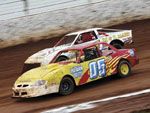
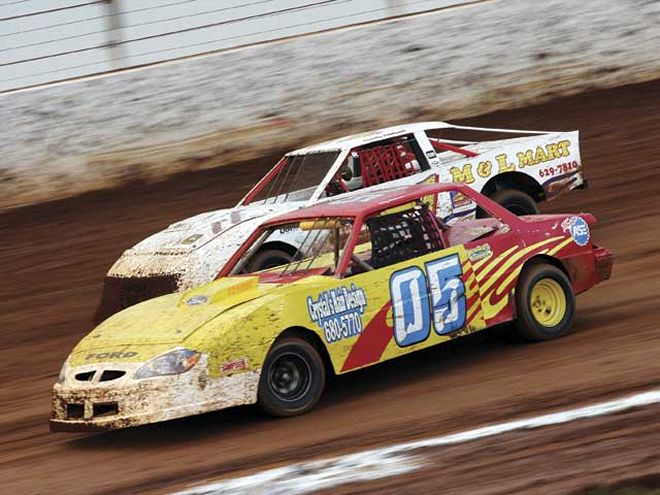 The Mini-Stock classes are no longer just for beginners. At the higherlevels, the competition is just as fierce as anything you will find inthe V-8 classes.
The Mini-Stock classes are no longer just for beginners. At the higherlevels, the competition is just as fierce as anything you will find inthe V-8 classes.
The Mini-Stock divisions racing four-cylinder engines were originallydevised as a great way to allow new racers to get their feet wet. Fewercylinders (and cubic inches) meant the cars were slower, and the ruleswere designed around keeping things affordable. That's still the way itis in many Mini-Stock divisions, but others have become much morecompetitive. Today, the four-cylinder classes at many tracks feature carcounts that are the same as the V-8s, and the competition is every bitas fierce.
Because maximum displacement in many Mini-Stock classes is limited to2,500 cc or less (152.5 ci), every little bit of power you can find isvaluable. Racers and engine builders fight for fractions of a pound oftorque, so it shouldn't be surprising that in many areas the mostcompetitive Mini-Stock engines are just as advanced as their V-8cousins. Lighter rotating assemblies, featherweight flywheels,small-journal cranks and rods, highly efficient belt and pulley systems,and the list goes on.
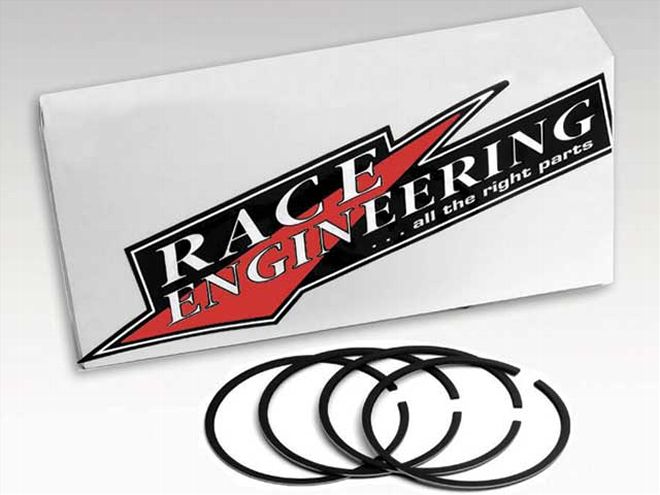 In order to cut frictional power losses, Race Engineering offers metricring packages originally designed for racing import cars.
In order to cut frictional power losses, Race Engineering offers metricring packages originally designed for racing import cars.
The biggest difference between the four-cylinder engines most commonlyraced--Ford's 2.3L and Toyota's 20R and 22R engines--and the V-8s isthat these tiny powerplants feature more modern overhead cam designs.Eliminating the pushrods and the associated weight that comes with itallows more rev-happy engines, but it also brings its own set ofoddities when it comes to setting up the valvetrain. For example, if yourun solid lifters in a Ford 2.3, they don't actually move. Need anotherexample? OK, valve stem length is just as important as the camshaft lobewhen it comes to determining valve lift.
Cam Protection
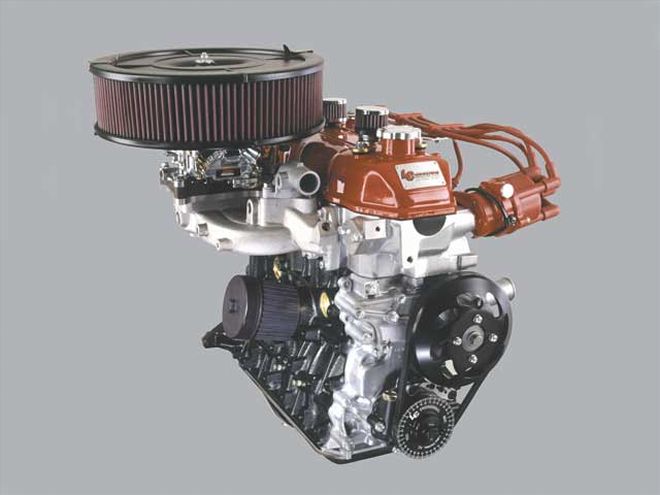 Toyota offered several engine combinations in four-cylinder form overthe years, but most are workable as race engines. This is LCEngineering's Stage Five race engine based on Toyota's 22R design.
Toyota offered several engine combinations in four-cylinder form overthe years, but most are workable as race engines. This is LCEngineering's Stage Five race engine based on Toyota's 22R design.
But the valvetrain, which in many ways has a moreefficient and simpler design than what is found in a traditional pushrodengine, also has its weaknesses when it comes to racing. Changing thecamshaft is one of the most effective things you can do whentransforming an engine designed for over-the-road service into a pieceof racing hardware. For both the intake and exhaust, anything you can doto increase flow through the speed at which the valve opens, the lengthof time it stays open (within limits), and maximum lift should increasepower. This results in some pretty radical camshaft lobes, and when youcombine this with the increased spring pressures necessary to controlthe valves at maximum rpm, conditions start getting pretty harsh. Thiswas particularly damaging in Ford 2.3 motors. The solution was to borrowtechnology from the F1 sector and start "nitride hardening" cams. Thenitriding process uses ammonia gas and high temperatures to infuse thecam with a ferrous nitride on the surface and significantly increasesboth the hardness and lubricity (how easily the material will slideagainst another). Today, most engine builders use nitrided cams in allracing applications for the Ford motor. It's easy to recognize one ofthese cams because they will appear matte black.
Easy Rings
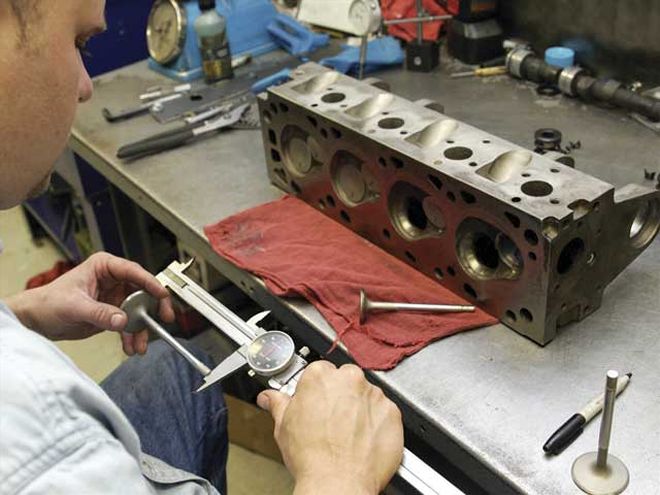 One of the biggest weaknesses of any Toyota four-cylinder is thesingle-width timing chain. LC Engineering has designed this double-widthchain, which is much tougher and will work in most applications.
One of the biggest weaknesses of any Toyota four-cylinder is thesingle-width timing chain. LC Engineering has designed this double-widthchain, which is much tougher and will work in most applications.
Racers have been competing with the same Ford 2.3 block forover 20 years. When Ford switched to fuel injection, engine builderssimply began milling out a hole in the block for the fuel pump.Thankfully, Ford has never made significant changes to the blockcasting, and the fuel-pump boss still remains.
So you imagine that there are very few big tricks left to be discoveredwhen it comes to building these little engines. Better metallurgy anddesigns are allowing manufacturers to pursue lighter parts, but thegains being made these days are in terms of fractions of a horsepower.
Race Engineering is one of the top companies supplying the four-cylinderengine builders. Its ultra-light components, such as the company'sadjustable square- and round-tooth timing pulleys and custom piston androd sets, are already well known among engine builders. But presidentBob Koch says he thinks there is more power yet in the piston rings.
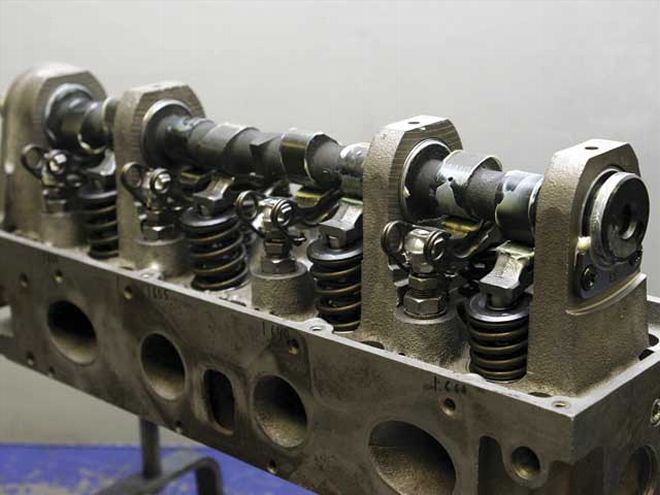 Ford's 2.3L overhead-cam cylinder head is a proven design and quitedurable when built correctly. It is, however, a completely differentanimal for anyone used to working with cam-in-block engines and cylinderheads.
Ford's 2.3L overhead-cam cylinder head is a proven design and quitedurable when built correctly. It is, however, a completely differentanimal for anyone used to working with cam-in-block engines and cylinderheads.
Besides oval-track racing, Race Engineering is also a big supplier ofengine parts for import cars, which are usually involved in drag racing.He's looking at using the lightweight rings designed for Hondas andother Japanese manufacturers and using them in the Ford engines. Thesemetric rings, he says, are not only thinner but also have less radialdepth (the thickness from the outside edge to the inside edge of thering) and less tension against the cylinder wall when not underpressure. Under compression, the pressure in the cylinder pushes therings against the cylinder wall to provide proper sealing, but otherwisethe rings cause less drag as the piston travels up and down. The rings'lighter mass also causes less ring flutter. Flutter, Koch says, is mostprominent in heavy rings, which have a greater resistance to changes indirection. Lighter rings carry less momentum, and when the pistonchanges direction they tend to stay seated against the piston's ringland better which improves the seal.
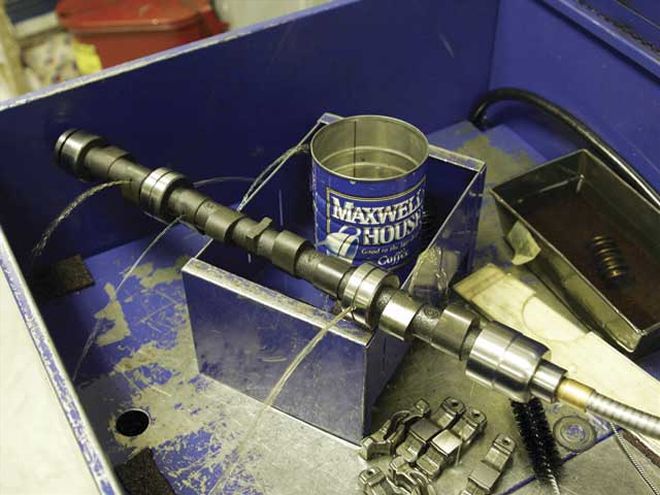 Nitrided camshafts are great at increasing longevity in cams withradical profiles. Still, you have to be very diligent when it comes tocleaning and prepping a new cam because of the oil galleries cut intoit.
Nitrided camshafts are great at increasing longevity in cams withradical profiles. Still, you have to be very diligent when it comes tocleaning and prepping a new cam because of the oil galleries cut intoit.
However, smaller metric rings require pistons with ring grooves cut tomatch. They also aren't available in some of the usual diameters. Kochsays that if an engine builder plans to use some of the most aggressivemetric rings, he must make the appropriate plans before machining theengine block. While good metric rings are available in the popular0.030-inch oversize, other cylinder bores must be planned around thereadily available metric diameter sizes. Koch says Race Engineeringoffers matched ring and piston sets and can give engine builders theexact dimensions to machine the block so that everything works togethercorrectly.
The Toyotas are Coming
 When cutting the seats in the 2.3 head, be careful to keep them all atthe same depth. Seat depth plays a role in maximum valve lift, and ifthey are all different, it can have you pulling your hair out atassembly time.
When cutting the seats in the 2.3 head, be careful to keep them all atthe same depth. Seat depth plays a role in maximum valve lift, and ifthey are all different, it can have you pulling your hair out atassembly time.
For years, the Fords have been the overwhelmingmajority in all levels of Mini-Stock racing, but lately the popularityof Toyotas among racers has been growing exponentially. Much of that isbecause the engines are plentiful and can be found in anything fromCelicas to pickups, and they are both simple and reliable.
When it comes to making power from Toyota's four-cylinder engines, oneof the top names in the business is definitely LC Engineering. Thecompany has specialized in Toyota racing engines for years in dragracing and off-road racing and has a long history of R&D on the littlemachines. Officials at LC Engineering say the most popular engines foroval-track racing use are the 20R and 22R cylinder heads (the blocks areinterchangeable with minor work), which are still readily availableeither in the junkyard or new. The 20R head features round intake andexhaust ports, 80cc combustion chambers, 43mm intake valves, and 35mmexhaust valves. It can be found in Toyotas built between 1975 and 1980.The 22R head was produced between 1981 and 1984. It features squareintake round exhaust ports, 82cc combustion chambers, and 44.5mm intakevalves matched with 36.5mm exhausts. Finally, the 22RE cylinder head wasproduced between 1985 and 1995. It can be identified by its squareintake ports and pear-shaped exhaust ports. They have 53cc combustionchambers and valves that are the same size as the 22R heads.
 Before assembly, Kevin Troutman measures and records the lengths for allhis valves. The distance that really matters is from the seat face onthe valve to the tip of the stem, but if the distance between the bottomof the valve and the seat face is consistent between the valvemeasuring, the total length is no problem.
Before assembly, Kevin Troutman measures and records the lengths for allhis valves. The distance that really matters is from the seat face onthe valve to the tip of the stem, but if the distance between the bottomof the valve and the seat face is consistent between the valvemeasuring, the total length is no problem.
LC Engineering says that all three engine combinations are workable foroval-track racing. All three designs used the same crankshaft andconnecting rods. The deck heights on the blocks vary, and Toyota handledthis by changing the compression height on the pistons. LC Engineering'stop-end race motor is called its "Stage Five" design and can use any ofthe heads. They do have different flow characteristics, but after portwork they are all capable of flowing the same numbers. The crankjournals are ground to accept Chevy rods, which gives LC Engineering agreater variety of choices when it comes to lightweight aftermarketrods. According to LC Engineering's tech department, the biggestweakness in the Toyota engines is the timing chain, which is asingle-row chain in stock form. They recommend upgrading to a double-rowchain so that it will hold up under racing stresses--something that LCEngineering does in all of its high-output engines.
Valvetrain Dynamics
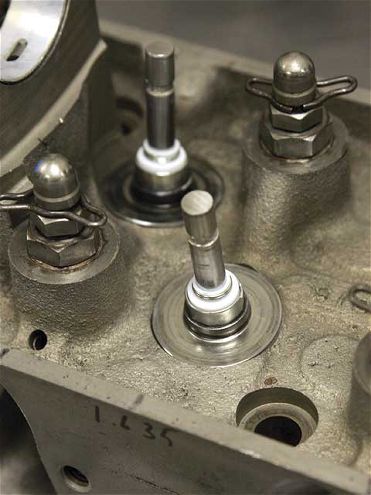 In a cylinder head equipped with solid lifters, the lifters are used toadjust both the lash and valve lift.
In a cylinder head equipped with solid lifters, the lifters are used toadjust both the lash and valve lift.
As we mentioned earlier, the greatest differencebetween an overhead cam engine and its cam-in-block pushrod cousin ishow the valvetrain is put together. Whether one system is more difficultto build and maintain is something we'll leave for others to argue, butone thing is for certain: If you are accustomed to buildingpushrod-based engines, building a cylinder head for a racing overheadcam engine is an entirely different animal. It can be quite difficultbecause one change--such as the depth of the valve seat--can affectclearances in several other areas of the head.
For that reason, we traveled to KT Engine Development as cylinder headspecialist Kevin Troutman rebuilt an overhead cam head for a Ford 2.3Lengine that races in a Mini-Stock class. One of the biggestdifficulties, Troutman says, is pushing the valve lift limits set by therule book while still keeping everything else correct to make sure theengine will live.
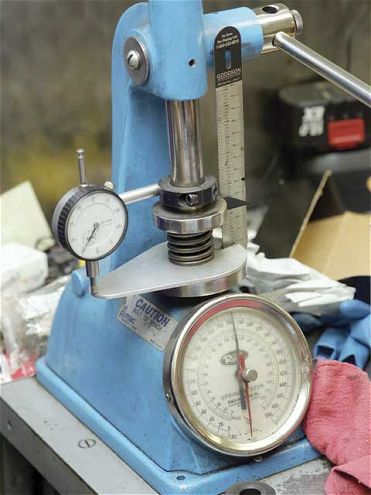 Troutman checks ahead of time to make sure that all the springs matchthe rated pressure and that they won't go into coil bind at the0.450-inch max lift mandated by the rules. Usually, you want an extra0.060 to 0.070 of room before coil bind at max lift. That means thesesprings shouldn't bind until they have been compressed at least 0.510 inch.
Troutman checks ahead of time to make sure that all the springs matchthe rated pressure and that they won't go into coil bind at the0.450-inch max lift mandated by the rules. Usually, you want an extra0.060 to 0.070 of room before coil bind at max lift. That means thesesprings shouldn't bind until they have been compressed at least 0.510 inch.
After cleaning and pressure-checking the head, Troutman performs all thenecessary machining steps to bring it back to spec. New valve seats are,of course, part of the package when rebuilding a head, but they arecritical in an overhead cam engine. Troutman must make sure they notonly remain as shallow as possible (to reduce shrouding and minimizecombustion chamber volume), but he must also try to keep the seats allat the same height relative to each other.
Unfortunately, when it comes to making sure the geometry is correct inan overhead cam cylinder head, the best way is simply to test-fiteverything. Even if it has the same specs as the previous cam, if youare installing a new camshaft you have to recheck everything because thesize of the base circle affects so much. Troutman begins by installingthe intake, exhaust valves, and springs into the first chamber andsliding the new camshaft into place in the head's cam towers. Afterinstalling the 1.66:1 ratio rocker arms between the solid lifters andthe valves, he sets the lash to 0.010 by adjusting the height of thelifter.
Troutman already knows that the springs (which are 100 pounds on theseat and 250 pounds over the nose) have more than the necessary 0.060 to0.070 clearance before going into coil bind at maximum valve lift--forthis head, it's limited to 0.450 inch by the rules for both the exhaustand intake valves. With everything installed, his biggest concern now isto make sure the camshaft provides the appropriate amount of lift to thevalves while staying centered on the hardened rocker pads.
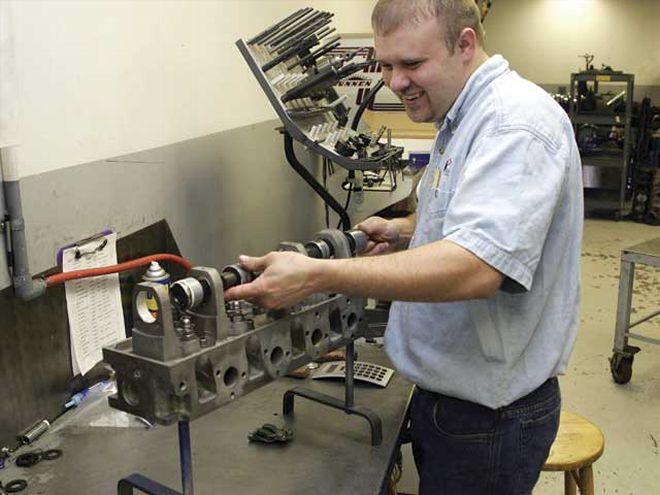 After coating the cam bearings with high-pressure lube, Troutmaninstalls the camshaft in preparation for his first test fit.
After coating the cam bearings with high-pressure lube, Troutmaninstalls the camshaft in preparation for his first test fit.
Adjusting lift is all a matter of raising or lowering the lifter inrelation to the top of the valve stem. Of course, doing this changes thelash also. To bring the lash back into spec, you have to adjust theheight of the top of the valve stem (which affects the height of thevalve side of the rocker arm). If that all sounds confusing, that'sbecause it is. We'll try to simplify things by walking through anexample.
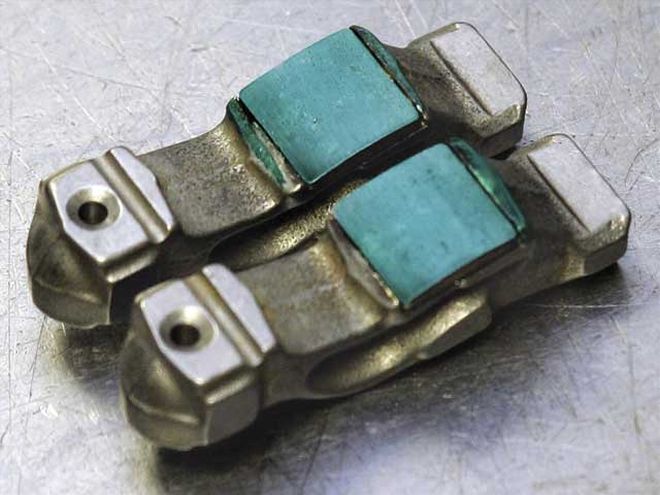 A pair of rockers are painted with machinist's dye to make sure the camlobes ride over the middle of the hardened pads.
A pair of rockers are painted with machinist's dye to make sure the camlobes ride over the middle of the hardened pads.
Looking at the cylinder head from the front, the first valve for thenumber-one cylinder is the exhaust. The lifter is on the right side, thevalve is on the left, and the camshaft rotates clockwise. The locationsfor the lifter and valve for the intake for that cylinder are reversed.For our example, let's say that the maximum valve lift exceeds themaximum 0.450 allowed by the rules. Increasing the stem height allowsyou to shorten the solid lifter, which will keep the lash the same andreduce lift. This can be done either by installing new valves withlonger stems, or, if you need to make only a small change, by grindingthe seat area of the valve itself. This allows the valve to sit deeperin the seat and raises the tip of the stem on the other side of thehead. If you need to increase lift, you can shorten the stem by grindingthe tip of the stem. This allows you to raise the lifter while keepingthe lash the same. Just be careful you don't grind so much that itcauses clearance problems between the rocker and spring retainer.
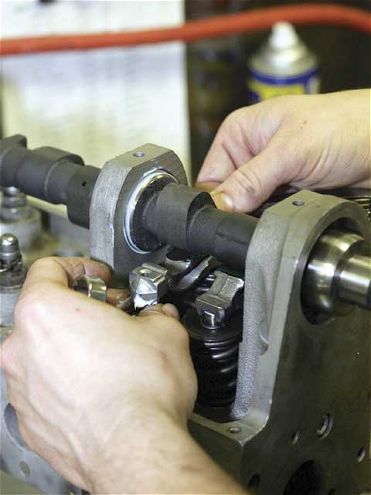 With the rocker in place, lash is set by adjusting the height of thelifter until you can just slide a 0.010 feeler gauge between the rockerpad and the base circle of the lobe on the camshaft. A nut on the lifterallows you to lock it down tightly.
With the rocker in place, lash is set by adjusting the height of thelifter until you can just slide a 0.010 feeler gauge between the rockerpad and the base circle of the lobe on the camshaft. A nut on the lifterallows you to lock it down tightly.
You can check valve lift by using a dial indicator on a metallic base.Set the indicator so that it rides on the spring retainer parallel withthe motion of the valve. Rotate the camshaft 360 degrees and see howmuch the retainer moves. Once you have the intake and exhaust correct,if the seat heights in the cylinder head are all same, you should beable to make the same changes to the rest of the valves. Regardless,make sure to always check every valve after final assembly. That's theonly way to know everything on your cylinder head is working properly.